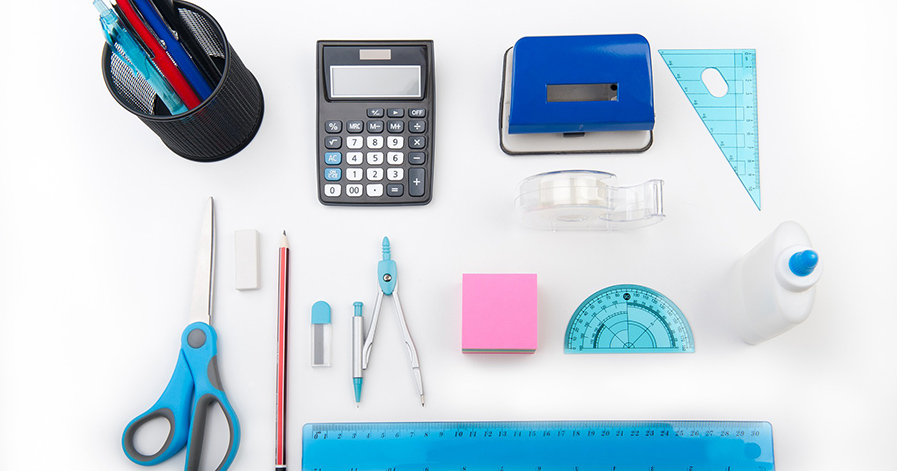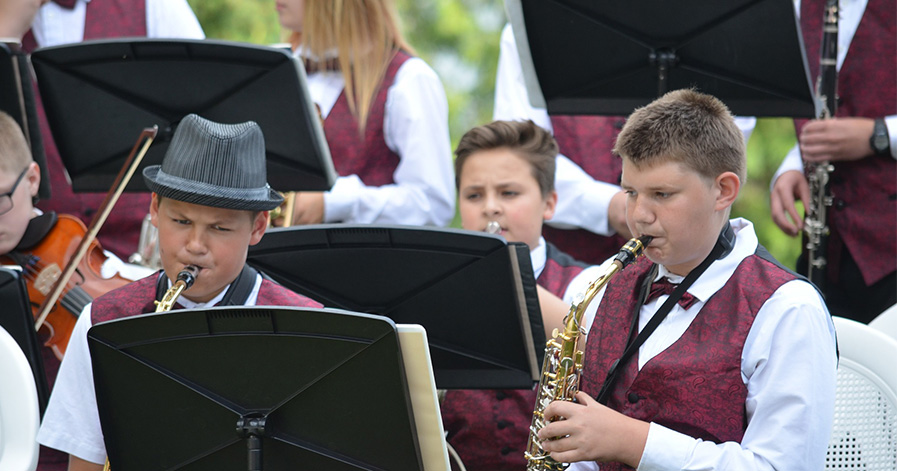The Tools to Learn: Making a School Supplies List
Every year as our children grow more mature and take on new milestones, their school supply needs change. From fall’s rainy days of galoshes and new pencils to the snow pants days of winter, you’ll be able to make sure your kids are prepared for anything with these age-appropriate lists.
Many of the school supplies remain fairly stable with minor changes in deference to developmental readiness.
Preschool and Kindergarten
Pre-K or preschool and kindergarten aged children are usually allowed outside for recess, so send them with extra warm clothes and waterproof shoes or galoshes as well as gloves or mittens, hats, scarves, boots, snow pants and the like.
- Pencil box
- Crayons
- Washable markers
- Pack of No. 2 “chubby” pencils: It’s recommended that these are larger sized, as they’re easier for small hands to hold. Young children have small hands and do not have the fine motor skills to control the slimmer pencils. You can also buy grips for the pencils, but those are usually for kids who need the grip for handwriting improvement even after their initial phase of writing instruction.
- Erasers: Large, stand-alone erasers
- Glue sticks: One or two for the pencil case, the rest stay home
- Safety scissors: A pair at home, a pair for school. These range from the blunt-tipped ones to the plastic-covered scissors.
- Plastic folders: They just hold up better than the cardboard ones, but of course it’s up to you. You should only need two, but get them in different colors, then designate one of them as a homework or take-home folder.
- Assorted construction paper: get it now so you’re not buying it at 8:00 the night before a project is due.
- Tissues: Personal, with an additional big box for the classroom
- Backpack: With appropriate size and support
- Lunchbox or bag
Optional
- Wipes or hand sanitizer, including cleaning wipes for the classroom teacher
- Pencil sharpener: You know what your kid can handle, but most kindergartners should be able to use a pencil sharpener without issue. You should have one at home at least.
- Wide-ruled loose leaf paper or handwriting paper (or both): Even if homework isn’t assigned, handwriting practice is always good. Children often like to re-enact their days as well, for example by playing school. This can be a wonderful way to practice new skills.
- Labels or a labeling marker for personal items and clothing
Seasonal
- Sunblock: Note that you may need a doctor’s note for this, and the teacher might not be allowed to put this on your child
- Hat
- Gloves, mittens, snow pants
- Boots or galoshes
- Outside/recess shoes
- Umbrella
First to Third Grade
- Pencil box
- Crayons
- Colored pencils
- Washable markers
- No. 2 pencils with pencil grips if needed: First graders will vary in skill less than their kindergarten counterparts, but you may still want the chubby pencils and grips as a transition to regular slim pencils.
- Pencil sharpener with a compartment to catch the shaving.
- Erasers: Stand alone and the type that fits over a pencil end. The traditional erasers usually work better than the novelty erasers.
- Glue sticks
- Assorted construction paper
- Wide-ruled notebook paper or notebook
- Tissues
- Backpack
- Ballpoint pens in blue or black
- Ruler
- Safety scissors
- Plastic folders: At least two, in different colors
- Index cards: For making flashcards of sight words and spelling words, for instance
- Lunchbox or bag
- Refillable water bottle
Fourth to Fifth Grade
- Pencil pouch
- Blue or black ballpoint pens
- No. 2 pencils: Pack of 8-12
- Pencil sharpener
- Highlighters: Two or three different colors
- Washable markers
- Erasers: Again, the novelty ones usually do not erase as well as the boring ones
- Three-ring binder
- Three-hole-punch: Can probably be kept at home
- Loose-leaf paper or spiral notebooks
- Subject dividers
- Index cards: plain white with lines on one side at least, plus a multicolored set is optional
- Plastic folders: At least two
- Glue: At least 2.7 ounces
- Ruler: 12 inch with mm, cm, and inches
- Scissors: Third graders can graduate to normal scissors now, though it's still good to have a blunted point
- Calculator: A simple one is fine, though it is good if it can do fractions and percentages
- Homework planner: One that has "week at-a-glance” pages as well as whole month pages
- Book covers
- Backpack
- Lunchbox or bag
- Closeable baggies: Good for pieces of projects, small slips of paper, etc.
- Plastic boxes for gym or outdoor shoes
- Extra gloves/mittens
Optional
- Colored pens: For peer grading and editing. Do not use these for assignments, though, as they're hard for teachers to read!
Middle and High School
An asterisk denotes items only necessary for high school.
- Pencil pouch
- Blue or black ballpoint pens
- Red pens/multicolored pens for peer editing and grading *
- No. 2 pencils: Pack of 12-24
- Pencil sharpener
- Highlighters: Multiple colors for annotating printouts and notes*
- Permanent markers such as sharpies*
- Erasers
- Three-ring binder: 1” or 1.5”
- Three-hole-punch: This can go to school and be kept in the locker or it can be kept at home
- Loose-leaf paper or spiral notebooks
- Graph paper
- Subject dividers
- Index cards
- Plastic folders
- Glue
- Sticky notes
- Tape: Clear and masking
- White-out
- Protractor
- Ruler
- Scissors
- Graphing calculator
- Combination lock: For gym lockers and possibly a bike lock
- Personal organizer/calendar
- Book covers or “socks”
- Backpack or messenger bag
- Lunchbox or bag
- Gym clothes plus spares
- Gym shoes
- Gym bag
- Towel
- Swimsuit
- Laptop or tablet with a case: They may need this in the even of BYOD. If not, they may need a case for a school-provided device.
- Hi-speed internet at home: Absolutely crucial. See your school for assistance if this is not feasible for you.
- Report folders: Covers for reports or papers
- A place at home for storage of old papers that may be of use later, divided by subject
- Water bottle
- Hair ties: For long hair for gym
- Poster board
- Sheet protectors
- Library card: Great resource and underutilized! Get one for your child as soon as you can.
- Any doctor’s notes, etc. for medications, bathroom breaks, IEP meetings, etc.
- Earbuds: Less clunky than headphones, but make sure they aren’t so cheap that everyone can hear what your child is listening to!
- Baggies
- Extra gloves/mittens
- Deodorant and hair supplies
- Hygiene products
- Extra underwear and socks: Something that people don’t always remember, but if gym class or sports practice get sweaty, extra undergarments will be much better to slip into after a shower than sweaty underwear that was worn all day!
Optional
- Hair cover: For swimming days
- Plastic boxes for gym or outdoor shoes
Final Thoughts
Most schools and teachers or school districts will send out a list of necessary supplies online, but not all of them do. Hopefully this list reminds you of some items you forgot to pick up or gives you a place to start as you start shopping. Teachers are also welcome to use this list as a starter for the lists they generate to send home.

